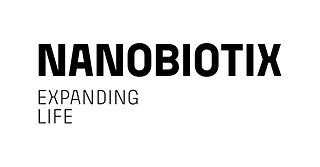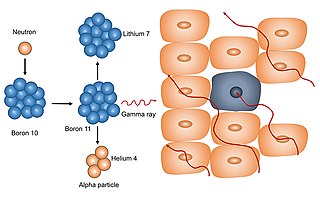
A radiosensitizer is an agent that makes tumor cells more sensitive to radiation therapy. It is sometimes also known as a radiation sensitizer or radio-enhancer.

A radiosensitizer is an agent that makes tumor cells more sensitive to radiation therapy. It is sometimes also known as a radiation sensitizer or radio-enhancer.
Conventional chemotherapeutics are currently being used in conjunction with radiation therapy to increase its effectiveness. Examples include the fluoropyrimidines, gemcitabine and platinum analogs; fluoropyrimidines increase sensitivity by dysregulating S-phase cell cycle checkpoints in tumor cells. Gemcitabine progresses through a similar mechanism, causing cells in the S-phase to disrepair DNA damage caused by the radiation. Platinum analogs such as cisplatin inhibit DNA repair by cross linking strands, and so aggravate the effects of DNA damage induced by radiation. [1] Mechanisms of Action Radiosensitizers enhance the effects of radiation therapy through various mechanisms, broadly classified as:
These agents increase DNA damage caused by radiation or inhibit its repair. [2]
Halogenated pyrimidines: Incorporate into DNA, making it more susceptible to radiation damage. Platinum analogs: Create DNA crosslinks, preventing repair. PARP inhibitors: Block DNA repair enzymes, increasing damage.
These agents disrupt the cell cycle, increasing radiosensitivity at specific phases. [3]
Taxanes: Arrest cells in the radiosensitive G2/M phase. Antimetabolites: Interfere with DNA synthesis, leading to cell cycle arrest.
These agents address low oxygen levels (hypoxia) in tumors, which can hinder radiation effectiveness. [4]
Nitroimidazoles: Mimic oxygen, enhancing free radical formation in hypoxic cells. Oxygen delivery agents: Improve oxygen supply to tumors.
One of the major limitations of radiotherapy is that the cells of solid tumors become deficient in oxygen. Solid tumors can outgrow their blood supply, causing a low-oxygen state known as hypoxia. Oxygen is a potent radiosensitizer, increasing the effectiveness of a given dose of radiation by forming DNA-damaging free radicals. Tumor cells in a hypoxic environment may be as much as 2 to 3 times more resistant to radiation damage than those in a normal oxygen environment. [5] Much research has been devoted to overcoming this problem including the use of high pressure oxygen tanks, blood substitutes that carry increased oxygen, hypoxic cell radiosensitizers such as misonidazole and metronidazole, and hypoxic cytotoxins, such as tirapazamine.
As of September 2016, there are a number of radiosensitizers in clinical trials.
| Name | Sponsor | Description |
|---|---|---|
| NBTXR3 | Nanobiotix | Also known as PEP503, NBTXR3 is injected via syringe directly into tumors by a surgeon. [6] [7] The drug then creates free radicals when exposed to x-rays. [7] It is composed of hafnium oxide nanoparticles. [6] [8] The company is running four trials on the drug simultaneously. The four trials are a Phase II/III in soft tissue sarcoma of the extremity and trunk wall, [9] a Phase I/II for hepatocellular carcinoma, [10] a Phase I/II for prostate cancer, [11] and a Phase I for squamous cell carcinoma of the oral cavity. [12] |
| Nimoral | Azanta | This compound increases the yield of DNA damage from irradiation under hypoxic conditions. Nimoral is in Phase III in Europe as a first-line therapy for squamous cell carcinoma of the head and neck. [13] |
| Trans Sodium Crocetinate (TSC) | Diffusion Pharmaceuticals | TSC is meant to increase the diffusion of oxygen through tissue. It was tested in a Phase II clinical trial in glioblastoma (GBM) patients. [14] The results of the Phase II showed that 36% of the full-dose TSC patients were alive at 2 years, compared with historical survival values ranging from 27% to 30% for the standard of care. [15] |
| NVX-108 | NuvOx Pharma | NVX-108 is an oxygen therapeutic that is injected intravenously, picks up oxygen in the lungs, and delivers oxygen to hypoxic tissue. It is a Phase Ib/II clinical trial where it raises tumor oxygen levels prior to radiation therapy in order to radiosensitize them. [16] |

Radiation therapy or radiotherapy is a treatment using ionizing radiation, generally provided as part of cancer therapy to either kill or control the growth of malignant cells. It is normally delivered by a linear particle accelerator. Radiation therapy may be curative in a number of types of cancer if they are localized to one area of the body, and have not spread to other parts. It may also be used as part of adjuvant therapy, to prevent tumor recurrence after surgery to remove a primary malignant tumor. Radiation therapy is synergistic with chemotherapy, and has been used before, during, and after chemotherapy in susceptible cancers. The subspecialty of oncology concerned with radiotherapy is called radiation oncology. A physician who practices in this subspecialty is a radiation oncologist.

Tumor hypoxia is the situation where tumor cells have been deprived of oxygen. As a tumor grows, it rapidly outgrows its blood supply, leaving portions of the tumor with regions where the oxygen concentration is significantly lower than in healthy tissues. Hypoxic microenvironments in solid tumors are a result of available oxygen being consumed within 70 to 150 μm of tumor vasculature by rapidly proliferating tumor cells thus limiting the amount of oxygen available to diffuse further into the tumor tissue. In order to support continuous growth and proliferation in challenging hypoxic environments, cancer cells are found to alter their metabolism. Furthermore, hypoxia is known to change cell behavior and is associated with extracellular matrix remodeling and increased migratory and metastatic behavior.

A glioma is a type of primary tumor that starts in the glial cells of the brain or spinal cord. They are cancerous but some are extremely slow to develop. Gliomas comprise about 30 percent of all brain tumors and central nervous system tumours, and 80 percent of all malignant brain tumours.

Glioblastoma, previously known as glioblastoma multiforme (GBM), is the most aggressive and most common type of cancer that originates in the brain, and has a very poor prognosis for survival. Initial signs and symptoms of glioblastoma are nonspecific. They may include headaches, personality changes, nausea, and symptoms similar to those of a stroke. Symptoms often worsen rapidly and may progress to unconsciousness.

Tirapazamine is an experimental anticancer drug that is activated to a toxic radical only at very low levels of oxygen (hypoxia). Such levels are common in human solid tumors, a phenomenon known as tumor hypoxia. Thus, tirapazamine is activated to its toxic form preferentially in the hypoxic areas of solid tumors. Cells in these regions are resistant to killing by radiotherapy and most anticancer drugs. Thus the combination of tirapazamine with conventional anticancer treatments is particularly effective. As of 2006, tirapazamine is undergoing phase III testing in patients with head and neck cancer and gynecological cancer, and similar trials are being undertaken for other solid tumor types.

Crocetin is a natural apocarotenoid dicarboxylic acid that is found in the crocus flower together with its glycoside, crocin, and Gardenia jasminoides fruits. It is also known as crocetic acid. It forms brick red crystals with a melting point of 285 °C.

Fast neutron therapy utilizes high energy neutrons typically between 50 and 70 MeV to treat cancer. Most fast neutron therapy beams are produced by reactors, cyclotrons (d+Be) and linear accelerators. Neutron therapy is currently available in Germany, Russia, South Africa and the United States. In the United States, one treatment center is operational, in Seattle, Washington. The Seattle center uses a cyclotron which produces a proton beam impinging upon a beryllium target.
The oxygen enhancement ratio (OER) or oxygen enhancement effect in radiobiology refers to the enhancement of therapeutic or detrimental effect of ionizing radiation due to the presence of oxygen. This so-called oxygen effect is most notable when cells are exposed to an ionizing radiation dose.

EF5 is a nitroimidazole derivative used in oncology research. Due to its similarity in chemical structure to etanidazole, EF5 binds in cells displaying hypoxia.

Evofosfamide is a compound being evaluated in clinical trials for the treatment of multiple tumor types as a monotherapy and in combination with chemotherapeutic agents and other targeted cancer drugs.

Veliparib (ABT-888) is a potential anti-cancer drug acting as a PARP inhibitor. It kills cancer cells by blocking a protein called PARP, thereby preventing the repair of DNA or genetic damage in cancer cells and possibly making them more susceptible to anticancer treatments. Veliparib may make whole brain radiation treatment work more effectively against brain metastases from NSCLC. It has been shown to potentiate the effects of many chemotherapeutics, and as such has been part of many combination clinical trials.

Temozolomide, sold under the brand name Temodar among others, is an anticancer medication used to treat brain tumors such as glioblastoma and anaplastic astrocytoma. It is taken by mouth or via intravenous infusion.

Nanobiotix is a biotechnology company that uses nanomedicine to develop new radiotherapy techniques for cancer patients. The company is headquartered in Paris, with additional corporate offices in New York and Massachusetts.

Neutron capture therapy (NCT) is a type of radiotherapy for treating locally invasive malignant tumors such as primary brain tumors, recurrent cancers of the head and neck region, and cutaneous and extracutaneous melanomas. It is a two-step process: first, the patient is injected with a tumor-localizing drug containing the stable isotope boron-10 (10B), which has a high propensity to capture low energy "thermal" neutrons. The neutron cross section of 10B is 1,000 times more than that of other elements, such as nitrogen, hydrogen, or oxygen, that occur in tissue. In the second step, the patient is radiated with epithermal neutrons, the sources of which in the past have been nuclear reactors and now are accelerators that produce higher energy epithermal neutrons. After losing energy as they penetrate tissue, the resultant low energy "thermal" neutrons are captured by the 10B atoms. The resulting decay reaction yields high-energy alpha particles that kill the cancer cells that have taken up enough 10B.
Alternating electric field therapy, sometimes called tumor treating fields (TTFields), is a type of electromagnetic field therapy using low-intensity, intermediate frequency electrical fields to treat cancer. TTFields disrupt cell division by disrupting dipole alignment and inducing dielectrophoresis of critical molecules and organelles during mitosis. These anti-mitotic effects lead to cell death, slowing cancer growth. A TTField-treatment device manufactured by the Israeli company Novocure is approved in the United States and Europe for the treatment of newly diagnosed and recurrent glioblastoma, malignant pleural mesothelioma (MPM), and is undergoing clinical trials for several other tumor types. Despite earning regulatory approval, the efficacy of this technology remains controversial among medical experts.

Sonodynamic therapy (SDT) is a noninvasive treatment, often used for tumor irradiation, that utilizes a sonosensitizer and the deep penetration of ultrasound to treat lesions of varying depths by reducing target cell number and preventing future tumor growth. Many existing cancer treatment strategies cause systemic toxicity or cannot penetrate tissue deep enough to reach the entire tumor; however, emerging ultrasound stimulated therapies could offer an alternative to these treatments with their increased efficiency, greater penetration depth, and reduced side effects. Sonodynamic therapy could be used to treat cancers and other diseases, such as atherosclerosis, and diminish the risk associated with other treatment strategies since it induces cytotoxic effects only when externally stimulated by ultrasound and only at the cancerous region, as opposed to the systemic administration of chemotherapy drugs.
An oxygen diffusion-enhancing compound is any substance that increases the availability of oxygen in body tissues by influencing the molecular structure of water in blood plasma and thereby promoting the movement (diffusion) of oxygen through plasma. Oxygen diffusion-enhancing compounds have shown promise in the treatment of conditions associated with hypoxia and ischemia. Such conditions include hemorrhagic shock, myocardial infarction, and stroke.

Diffusion Pharmaceuticals Inc (NASDAQ:DFFN) is a publicly traded biotechnology and drug development company based in Charlottesville, Virginia, U.S. It was co-founded in 2001 by American life sciences entrepreneur David Kalergis and University of Virginia Chemical Engineering Professor John L. Gainer. Gainer is the inventor of the company's platform technology of oxygen diffusion-enhancing compounds and its lead drug, trans sodium crocetinate (TSC). TSC acts to increase the rate at which oxygen moves through blood plasma by the process of diffusion, a phenomenon that forms the basis for the company's name. On January 8, 2016, the formerly privately held company merged with Restorgenex Corporation to become a publicly traded NASDAQ-listed company with the trading symbol DFFN. TSC and other oxygen diffusion-enhancing compounds, including bipolar trans carotenoid salts, have been investigated by Diffusion Pharmaceuticals for treatment of conditions associated with reduced oxygen availability in tissues (hypoxia). Most recently, Diffusion has begun the initiation of clinical trials in the U.S. and Eastern Europe for the use of trans sodium crocetinate in the treatment of COVID-19 patients with respiratory distress-related oxygen deficiency and the risk of multiple organ failure.

18F-FMISO or fluoromisonidazole is a radiopharmaceutical used for PET imaging of hypoxia. It consists of a 2-nitroimidazole molecule labelled with the positron-emitter fluorine-18.
In biochemistry, the oxygen effect refers to a tendency for increased radiosensitivity of free living cells and organisms in the presence of oxygen than in anoxic or hypoxic conditions, where the oxygen tension is less than 1% of atmospheric pressure.
![]() This article incorporates public domain material from Dictionary of Cancer Terms. U.S. National Cancer Institute.
This article incorporates public domain material from Dictionary of Cancer Terms. U.S. National Cancer Institute.